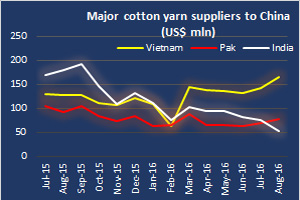
Are yarn exporters showing sign of Ostrich Syndrome as Pakistan pips India to third?
YarnsandFibers News Bureau 2016-09-30 10:37:00 – MumbaiAfter Vietnam relegating India to second since March this year, now Pakistan pips India to third position in supplying cotton yarn to China. India was until February, the top cotton yarn supplying nation to China. In August 2016, Pakistan overtook India by supplying 34 million kgs of cotton yarn while India could ship only 21 million kgs and Vietnam heading at 61 million kgs. Exactly a year ago, India had exported 66 million kgs with Vietnam at 45 million kg and Pakistan at 41 million kg.
What factors could have suddenly changed yarn sourcing by China. Is it pricing, timely shipment, quality, payment terms, or “something elseâ€.? If one looks at pricing, Pakistan remains the cheapest among top three suppliers and Vietnam the highest. Assuming ceteris paribus accepting for pricing, there has been price elevation between July and August, the months when imports from India were at their abysmal. Import prices were up US cents 13 a kg from India, US cents 11 from Vietnam and just US cents 6 from Pakistan. Thus, Pakistan still appears be the cheapest supplier of cotton yarn. However, year on year comparison shows prices down US cents 17 in India, US cents 12 in Vietnam and flat in Pakistan.
Explaining “something elseâ€, total imports of cotton yarn in China has fallen during the period under review and for goods covered under HS codes 5204, 5205,5206, and 5207. The first eight months of 2016 saw total imports declining 18% in volumes and 25% in value. Dynamics seem to have change – lower imports despite falling prices, while economic theories advocate vice-versa. Imports from India was down 46% during the period in value terms and 41% down from Pakistan. However, import from Vietnam was up 7% in value and 19% in terms of volume.
China being the largest exporter of fabrics and garments in the world, its trade has slowed down or rather declined in 2016. Fabric exports were down 2% in the first half of 2016 while garment export shrank 5%. This partly explains the subdued environment in textile sector.
Under such circumstances, Indian yarn exporters are losing on two fronts. One, they have been toppled by Vietnam and now Pakistan, and two, the slackness in textiles industry in China. And these signs have been emerging over the period, but were presumed to be short lived or have remained unseen by Indian exporters. Now, that competitors have emerged to be winners, what will yarn makers in India do. They may either run to the government to bail out of the situation or may show Ostrich Syndrome. But what will China do boost its textile industry after investing huge money in synthetic fibres will need a closer examination.
Market Intelligence
Ask for free sample Report

experience
Customer Base
dedicated team
Countries Served Worldwide









